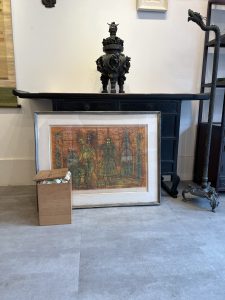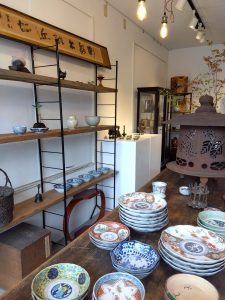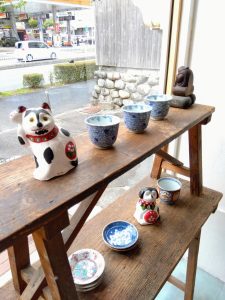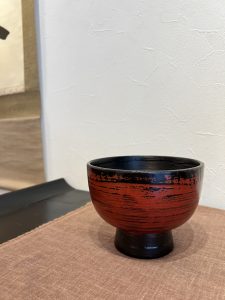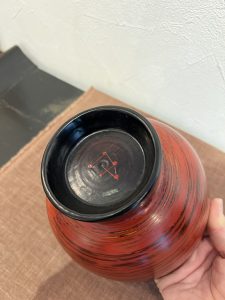皆さまこんにちは。スタッフHでございます。
秋の風が心地よい今日この頃。長い夏の間「暑い」と言いすぎた反動なのか、「涼しい!」を必要以上に口にしている気がします。
そろそろ温かいお茶で一息入れる時間も増えてくるのではないでしょうか。余裕がない時はマグカップでお茶をがぶがぶと飲んでしまう私ですが、たまには趣のある茶器で一口ずつ味わいながら、美味しいお茶をいただきたいものです。

こちらは沈存周(1629~1709)の錫製の茶托です。沈存周は中国の清の時代の錫器の優れた名工であり、詩人でもありました。主に茶道具に詩と共に山水画などの絵を彫り、錫器の価値を高めたと言われています。沈存周は別号の「仙子」という文字を刻んだ茶器も制作しており、同じく価値のあるものとされています。
錫器は使い込むほどに古色が加わり光沢が増し、価値も上がっていきます。こちらの5客セットの茶托も漢詩とその情景を表した絵が錫の変化と共に味わい深い姿になっており、手にも自然と馴染みます。

どのような情景が描かれているのか、目を凝らして見てみました。
その前にまず漢詩について少し復習をさせてくださいね。漢詩は大きく分けて「古体詩」と「近体詩」に分けられ、古体詩は定まった型がありませんが、近体詩は唐以降に作られた一定の型に従っています。現在よく目にする漢詩は近体詩です。
また1句が5文字からなる詩を「五言詩」、7文字からなる詩を「七言詩」と呼ぶので、こちらの茶托の詩は「七言詩」になるかと思います。さらに近体詩は通常、偶数の句からなり一首が4句のものを「絶句」、7句のものを「律詩」と呼びます。
私の知っている数少ない漢詩「春暁」春眠暁を覚えず…は5文字の4句なので「五言絶句」となるのですね。
春眠不覚暁/処処聞啼鳥/夜来風雨声/花落知多少
「絶句」では第1句を起句、第2句を承句、第3句を転句、第4句を結句と呼び、「起承転結」という語の元となっています。
こちらの茶托の詩も5句で一つの漢詩になっているのかなと思っていましたが、奇数になるので定型にはあてはまらず、古体詩?などと一人で勝手に推測し、結果、絵が描かれているので1客で詩が完成しているはずと根拠もなく納得しています。
「違うよー」というお声も聞こえてきますが、勉強中の身ですのでご容赦ください。
目を凝らしては見るのですが、なにせ知識が足りず、判読が難しいです。唯一読めた気がする詩はこちら。
秋日 錦門 雅人楽 真ん中下に人の姿が描かれています。紅葉した木々の門を楽しみながら見ているのでしょうか。
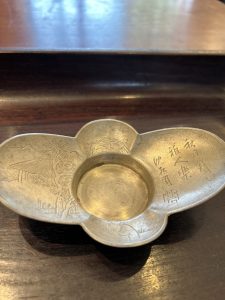
そしてこちらの茶托には「陸羽 煮茶」の文字が。陸羽とは唐の時代にお茶の専門書「茶経」を書いた人物です。お茶の起源や製造方法、茶器、お茶の淹れ方、飲み方、産地などが書かれており中国茶のバイブル的な存在です。この書物を書いた時、陸羽はまだ20代だったそうです。陸羽以前はお茶は単なる飲み物にすぎず、陸羽以降、お茶は精神性・神聖さを帯び、のちの日本の茶道にをつながっていくとのこと。こちらの茶托にも茶道具がたくさん描かれていて楽しいです。

こちらは「柘榴(ざくろ)」でしょうか?
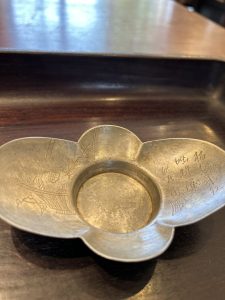
こちらも奥に人が佇んでいますね。
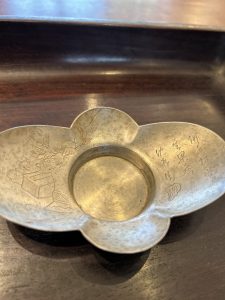
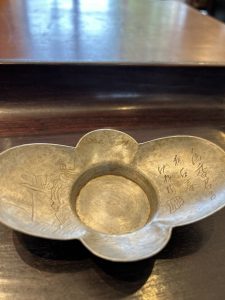
しばらく眺めながら妄想を膨らませて楽しみたいと思います。
それでは、またお会いしましょう。
Hello everyone. This is Staff H.
The autumn breeze is pleasant these days. Perhaps it is a reaction to the long summer, during which we said “hot” too much, but I feel that we are saying “cool! I feel like I am saying “cool!” more than necessary.
I think it is time to take a break with a cup of hot tea. I tend to gulp down tea in a mug when I can’t afford it, but once in a while I would like to savor a good cup of tea in a tasteful tea cup, savoring each sip as I sip.
This is a tin saucer made by Shen Zun Zhou (1629-1709). Shen Zun-chou was an excellent tinware master craftsman and poet in the Qing Dynasty of China. He is said to have engraved landscapes and other pictures along with poems mainly on tea utensils, thereby enhancing the value of tinware. Shen Zun Zhou also produced tea utensils engraved with the character “Xian Zi,” which is another name for the tea ceremony, and is also considered to be of great value.
The more tinware is used, the more it becomes old and shiny, and the more valuable it becomes. This set of five saucers also features Chinese poems and pictures depicting scenes, and the tin changes with time, making the saucers more comfortable to hold in the hand.
We took a closer look at them to see what kind of scenes are depicted on them.
Before that, let me first review a little about Chinese poetry. Chinese poetry can be roughly divided into “ancient style poetry” and “modern style poetry.” While ancient style poetry has no fixed form, modern style poetry follows a certain form created after the Tang Dynasty. The Chinese poetry we see today is kintai-shi.
A poem consisting of five words is called a “five-word poem” and a poem consisting of seven words is called a “seven-word poem,” so I think the poem on the saucer here is a “seven-word poem. Furthermore, kintai poems usually consist of an even number of phrases, and those with four phrases per poem are called “zekku,” while those with seven phrases are called “ritsu-shi.
One of the few Chinese poems I know, “Chun Xiao” (Spring Dawn), which is about not to wake up at dawn in spring sleep, has four five-character phrases, so it is a “five-word zekku” poem.
Spring sleep and the dawn do not wake me / the place where I hear the birds singing / the wind and rain come in the night / the flowers fall and know more or less.
In “Zekku,” the first phrase is called “Ki-Kiku,” the second “Sei-Kiku,” the third “Teng-Kiku,” and the fourth “Conclusion,” which is the origin of the term “Ki-Sei-Ten-Ketsu.
I was wondering if the poem on the saucer was also a Chinese poem with 5 phrases, but since the number of phrases is odd, it does not fit the formula. I guessed on my own that the poem should be completed by one guest since the picture is drawn, without any evidence.
I hear some people say, “No, it is not,” but I am still in the process of learning, so please forgive me.
I try to look at it carefully, but I do not know enough about it, and it is difficult to decipher. Here is the only poem I think I could read.
Autumn sun, Kinmon (Kinmon), Gajinraku (Gajinraku). Is he or she looking at the gate with enjoying the autumn leaves?
And 0n the saucer here are the words “Luwu Boiled Tea”. Lu Yu was a person who wrote the “Tea Sutra,” a technical book on tea during the Tang Dynasty. It is a bible of Chinese tea, describing the origins of tea, production methods, tea utensils, how to brew tea, how to drink tea, where tea is produced, and more. When he wrote this book, Rikuu was still in his 20s. Before Rikuu, tea was merely a drink, but after Rikuu, tea took on a spirituality and sanctity that later led to the Japanese tea ceremony. I enjoy the many tea utensils depicted on these saucers as well.
Is this a “pomegranate”?
There is also a person standing in the back.
I would like to enjoy looking at them for a while and letting my imagination run wild.
Well, I will see you again.
*******************
ご実家の整理やお片付けなどをされている方のご相談などが多くございます。
お片付けなどくれぐれもご無理のないようになさってくださいませ。
風光舎では古美術品や骨董品の他にも絵画や宝石、趣味のお品など様々なジャンルのものを買受しております。
お片付けをされていて、こういうものでもいいのかしらと迷われているものでも、どうぞお気軽にご相談下さいませ。
また風光舎は、出張買取も強化しております。ご近所はもちろん、愛知県内、岐阜県、三重県その他の県へも出張いたします。
まずは、お電話お待ちしております。
愛知県名古屋市千種区姫池通
骨董 買取【古美術 風光舎 名古屋店】
TEL052(734)8444
10:00-17:00 OPEN
#出張買取#骨董#古美術#骨董品#絵画#版画#茶道具#刀剣#彫刻

